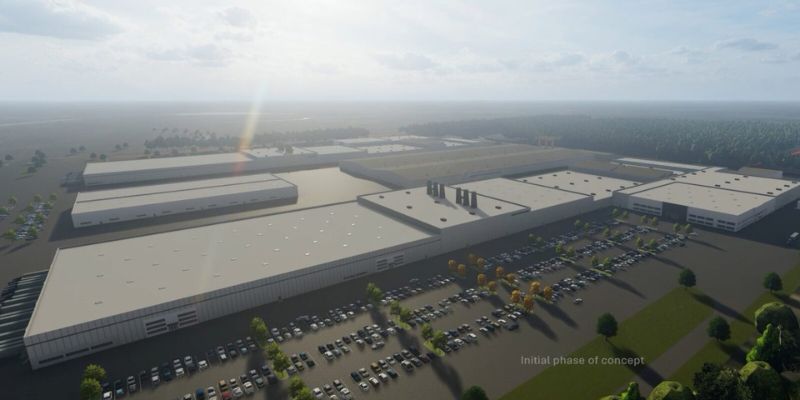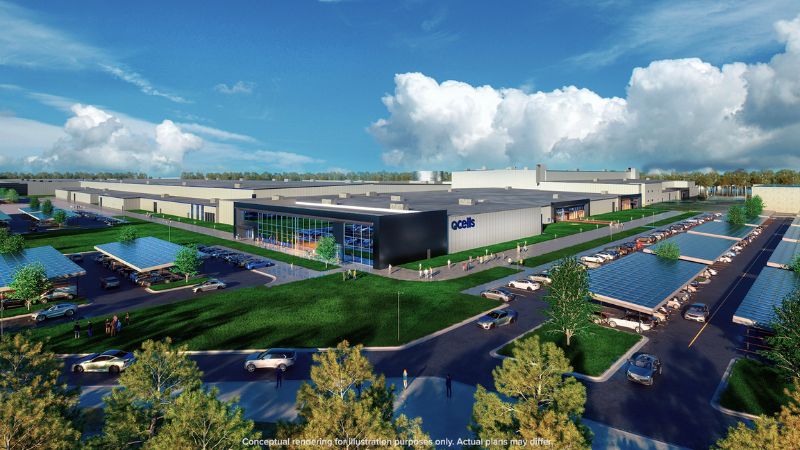US Commits $150B to Cleantech Manufacturing in 8 Months
A report from industry trade group American Clean Power shows an unprecedented number of clean energy facilities and expansions in the United States, spurred mainly by federal incentives.
American companies committed a whopping $150 billion in new clean energy manufacturing investments over the last eight months, according to a new report from American Clean Power (ACP).
A rendering of the first phase of FREYR’s upcoming gigafactory in Georgia, where it will produce battery cells for energy storage systems. Image used courtesy of FREYR
Drawing data from its member base of 1,000-plus companies and public information sources, the Washington, D.C.-based trade group tracked dozens of announcements by utilities and independent power producers following the Inflation Reduction Act (IRA). Though the $738 billion spending package was signed into law in August 2022, companies didn’t start leveraging the $370 billion sum earmarked for renewable energy investments until late-2022 and earlier this year.
The industry has announced 46 new plants, expansions, or reopenings since last August, according to ACP’s report. Together, those projects will add 96 gigawatts (GW) of manufacturing capacity, creating 18,000 jobs and $4.4 billion in savings for 24 million customers.
Twenty-six solar projects comprised the majority of new manufacturing facilities or expansions tracked in the report, followed by ten utility-scale battery storage production plants, eight wind power facilities, and two offshore wind sites. The projects are spread nationwide, with hot spots in the Southeast (Georgia and South Carolina), Texas, Ohio, parts of the Midwest, and Arizona.
Unpacking the Data: Snapshot of the Largest Projects
Another 11 facilities, primarily solar, haven’t selected locations yet. Sixteen facilities are scheduled to come online later this year, while about a dozen are planned for 2024 and four for 2025. The rest are slated for 2026 or to-be-determined.
Among those with the highest capital commitments is a $2.5 billion project by Qcells to build a solar factory in Georgia, adding around 2,500 jobs and new capacity for components such as silicon ingots, wafers, cells, and modules. A subsidiary of Qcells’ parent company, South Korea-based Hanwha Group, also announced a $147 million investment in Georgia to supply Qcells with encapsulant film ethyl vinyl acetate for its solar modules, creating over 160 jobs.
A rendering of Qcells’ upcoming solar component manufacturing facility in Georgia. Image used courtesy of Qcells
Another major project is LG Energy’s $2.3 billion lithium iron phosphate (LFP) battery production facility for energy storage systems in Arizona. Opening in 2026, the plant is expected to have an output of 16 GWh annually. It’s part of a larger $5.5 billion project earmarking $3.2 billion to construct a cylindrical battery manufacturing facility for electric vehicles, totaling 27 GWh of annual capacity.
In another win for Arizona, American Battery Factory will invest $1.2 billion to build the country’s largest gigafactory for LFP battery cell production, spanning 2 million square feet in Tucson. The facility is the first in a series of planned gigafactories across the U.S.
Another pair of investments topped $1.7 billion each: A new facility from Nucor Steel recently started producing steel plates in Kentucky for offshore wind customers. Meanwhile, FREYER is developing a multi-phase lithium-ion battery cell production facility in Georgia, initially with an annual capacity of 34 GWh. After its initial announcement last November, the Norwegian battery startup now says it will accelerate its plans after the IRA provided tax credits of $37 million per GWh of capacity installed in the U.S.
FREYR has selected a site in Coweta County, Georgia, for a multi-phase Giga America clean battery manufacturing project from FREYR Battery. Video used courtesy of Vimeo
The report also lists several projects with investments under $1 billion. Notably, Illuminate USA is investing $600 million for a 1.1 million-square-foot solar module facility in Ohio, delivering up to 5 GW of capacity once operations launch by the fourth quarter of 2023. Another major project is a $279 million lithium-ion battery cell manufacturing plant in South Carolina by Pomega Energy Storage Technologies, with production slated to begin in mid-2024.
Expanded and Reopened Facilities
ACP’s report outlines several newly announced facility expansions and upgrades. CS Wind, for example, is expanding its Colorado wind turbine tower manufacturing plant, doubling its output to 10,000 turbine towers annually and adding 850 jobs. The first of the project's three phases is expected to finish next summer. Meanwhile, First Solar is investing $185 million to upgrade its solar module capacity by 900 megawatts (MW) at its Northwest Ohio facilities.
CS Wind is adding 900,000 square feet to its Colorado wind turbine tower manufacturing plant. Image used courtesy of Burns & McDonnell
General Electric will also invest $20 million to ramp up production at its nacelle manufacturing facilities in Florida, while Qcells will expand its solar assembly plant in Dalton, Georgia, by 2 GW annually.
The IRA’s generous funding allocations have also helped reopen several shuttered or idle facilities. Some include: Two wind turbine and nacelle manufacturing plants in Iowa and Kansas owned by Siemens Gamesa (with production restarting this year); TPI Composites will reopen its turbine blade plant that closed in 2021 with 700 jobs cut; and REC Silicon and Mississippi Silicon will resume production at an idle solar-grade polysilicon manufacturing facility in Washington.
What’s Next for Cleantech?
ACP’s report suggests a strong market, to be sure—one that’s overwhelmingly driven by federal subsidies, tax credits, and economic development grants allocated to states via the U.S. Department of Energy. Before the IRA, it was unprecedented for companies to commit $150 billion in clean energy manufacturing investments in less than a year. Today, however, it surpasses the total of clean power projects coming online between 2017 and 2021.
Still, ACP’s report called for the Biden Administration and Congress to improve trade policies, continue supporting advanced technology development, finalize the implementation of tax policies, and reform permitting processes. ACP plays a role in these negotiations as one of the largest cleantech lobbying groups in the U.S. Surrounding the passage of the IRA, ACP’s lobbying expenditures totaled $1.9 million in 2021 and $1 million in 2022, according to OpenSecrets data.
America’s clean energy demand currently outpaces its components and raw materials supply. IRA funds are expected to boost that share in the coming years, though the effort still entails substantial private-sector commitments. Even so, in the solar industry alone, the IRA is expected to bring domestic module production capacity from 9 GW in 2022 to 25 GW by the end of this year, according to the Solar Energy Industries Association.









